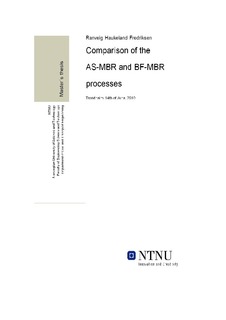| dc.contributor.author | Fredriksen, Ranveig Haukeland | nb_NO |
| dc.date.accessioned | 2014-12-19T12:31:24Z | |
| dc.date.available | 2014-12-19T12:31:24Z | |
| dc.date.created | 2011-05-25 | nb_NO |
| dc.date.issued | 2010 | nb_NO |
| dc.identifier | 419140 | nb_NO |
| dc.identifier.uri | http://hdl.handle.net/11250/242144 | |
| dc.description.abstract | Active sludge membrane bioreactor (AS-MBR) is a process of membrane separation of activated sludge. This is increasingly becoming an alternative for wastewater treatment plants as improved effluent quality often is required together with special limitations. A major drawback for the process is however membrane fouling, which needs to be further handled in order to create a cost-beneficial solution. Fouling can potentially be reduced by applying biofilm (BF) instead of activated sludge. Prospects of even more compact plants, with reduced aeration requirements, and improved effluent quality are other driving forces for investigation of BF-MBR. The limited literature concerning BF-MBR illustrates however varying degrees of success. The first part of this report presents the available knowledge on fouling in both AS-and BF-MBRs.
The overall objective of this thesis was to carry out a comparison between membrane performances in the two systems. This was done by operating two equal pilot plants in parallel for several months, while water quality and fouling were measured.
The results revealed less fouling and better treatment in the AS-MBR. Additionally, it was found that the AS-MBR reactor water contained significantly less submicron organic material which often is found to be an important foulant. In order to evaluate the impact on the membrane performance, the amount of suspended solid was increased in the BF-MBR. A clear improvement was found with increased amounts of suspended solids, and the finalexperiment indicated even better membrane performance when compared to the AS-MBR. Some suspended solid should therefore be present in order to form of a protective cake layer on the membrane surface and prevent other foulants from adsorbing directly to the membrane. The suspended solids may also flocculate the smaller foulant prior to deposition on the surface. Increased operating problems regarding BF sludge needs however further analysis. The results obtained in this study supports that the BF-MBR membrane can be operated just as well the AS-MBR, or maybe even better under the right circumstances. Configurations with increased amounts of suspended solid in an external membrane reactor should therefore further be evaluated, as well as the prospects of an optimum concentration of suspended solid. | nb_NO |
| dc.language | eng | nb_NO |
| dc.publisher | Norges teknisk-naturvitenskapelige universitet, Fakultet for ingeniørvitenskap og teknologi, Institutt for vann- og miljøteknikk | nb_NO |
| dc.title | Comparison of the AS-MBR and BF-MBR processes | nb_NO |
| dc.type | Master thesis | nb_NO |
| dc.contributor.department | Norges teknisk-naturvitenskapelige universitet, Fakultet for ingeniørvitenskap og teknologi, Institutt for vann- og miljøteknikk | nb_NO |
